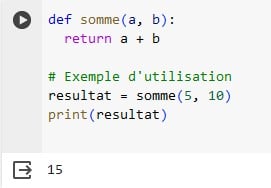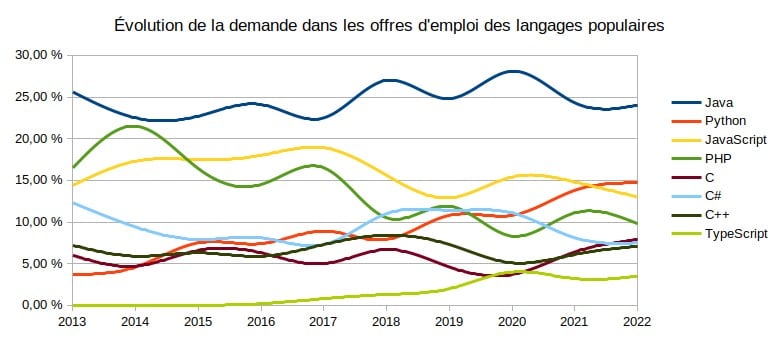Python has become the language to learn. Why should you be interested? What are its advantages over other languages? What are its applications? What training courses should you take?

If there's one computer language you need to learn right now, it's Python. Having dethroned C, C++ and Java, it now dominates the international rankings. TIOBE Index and PYPL since 2021.
More than 20 % of developers use Python, or 11.3 million people worldwide, according to a Slashdata study carried out in 2023.


But why is it so popular?
The main attraction of Python is its simplicity. But behind this simplicity lies tremendous versatility.

Invented in 1991 by the Dutchman Guido van Rossum as a tribute to the British comedians Monty Python, Python is used in a wide variety of fields and applications. It is used in artificial intelligence, web development, big data and system administration.
Let's take a closer look at the ten reasons why you should adopt it.
10 reasons to learn Python
1. Python is easy to learn
There's no need to spend days getting to grips with it like other more arduous languages such as C and Perl. Designed to be readable, Python shines for its simplicity and precision of its syntax.
Blocks of code are identified by indentation (positional syntax), instead of braces as in C, C++ or Java. Increasing the indentation marks the beginning of a block, and decreasing the indentation marks the end of the current block.
Blocks can be nested.
Code examples to calculate the sum of 2 numbers
- With Python

- With C++

Python is therefore perfectly suited to programming beginners. That's largely why it has replaced Pascal in schools, and why algorithms are taught in Python from the second year of secondary school.
Python is a high-level languagewhich means it is close to natural language and independent of the machine on which it runs. It is also a an object-oriented language that supports object-oriented programming in addition to other paradigms.
2. It's an effective language
This streamlined syntax makes it a highly efficient language. A Python program consists of 3 to 5 times fewer lines of code than its Java equivalent. It also requires around 5 times less development time.
Example of calculating the factorial of a number
- In Python: 5 lines of code

- In Java, 15 lines of code

3. It is versatile
Python is used by many different professions, in a wide variety of applications and business sectors.

- Web development
- Back-end web developer Creating server-side web applications, such as APIs and web frameworks.
- Full-stack web developer Create complete web applications, both server-side and client-side.
- DevOps Engineer automate infrastructure and deployment tasks.
- Data science and data analysis
- Data scientist analysing data, creating business modelsmachine learning and view the results.
- Data analyst data collection, cleansing and analysis.
- Artificial intelligence
- Artificial intelligence engineer developing intelligent systems, such as chatbots and conversational agents.
- Engineer in machine learning Developing and deploying machine learning models.
- Engineer in deep learning developing deep neural networks for computer visionnatural language processing and other fields.
- Other areas
- Software development Creating desktop software, mobile applications and games.
- System administration : create scripts and automate system administration tasks.
- Finance : develop trading and financial analysis software.
- Science: scientific research in fields such as physics, biology and chemistry.
4. An open source language
Distributed under an open licence, Python is completely free. Its code is accessible and can be freely modified. It is possible to use Python and its modules in a commercial application without having to pay royalties, which helps to reduce the costs associated with software development.
5. An interpreted language
The code is executed line by line by another program called the interpreter. Interpreted languages are more flexible, unlike compiled languages, which transform the source code into machine code.

It is therefore easy to test a small piece of code.
To start the interpreter, simply type: $ python 3
On the other hand, Python is relatively slow compared with other languages, particularly the 3 Cs: C, C++ and C#. To improve performance, you can use one of the many JIT compilers, which compile the code at runtime. Python version 3.13 comes with such a compiler.
6. Multi-platform and multi-architecture
Because it's an interpreted language, Python is portable It can run on any computer, whatever the operating system (Windows, macOS, Linux, Android, iOS, etc.) or processor architecture (Intel, Qualcomm Snapdragon, Raspberry Pi, etc.), so you can develop cross-platform applications.
It is found on large Unix servers as well as on nanocomputers or smartphones.
7. A wide range of libraries and frameworks
Python comes with a standard library for all common operations. A library (library is a collection of functions linked to a specific theme. It is the wealth of its specialised libraries that extends the possibilities of the language and speeds up development work.
Let's quote Numpy for scientific and statistical calculations, pandas to manipulate and analyse data tables, Matplotlib to display tables and graphs, BeautifulSoup to extract data from the web (web scraping).
PyTorch, TensorFlow, scikit learn to develop machine learning and deep learning (deep learning),
In addition to libraries, frameworks have been developed to facilitate work in specialised areas such as Django for server-side development.
8. A large community
Python has an active and dynamic community of developers who contribute to its development, technical support and the creation of numerous modules and libraries. Python libraries are catalogued and freely accessible in the official Pypi repository, which lists over 517,000 projects!
9. Python makes it easy to create variables
You do not need to declare the type of variables in advance. Its type is automatically determined by the value assigned to it (dynamic typing).
The syntax for creating variables is simple: simply assign a value to the variable using the equals sign (=).
What's more, you can assign several values to several variables in a single line of code.
Changing the type is very easy, as it can be done while the program is running. In the example below, the value of x changes from an integer to a character string.


10. Used by many companies
Many large companies and organisations claim to use Python: Google, Amazon, Nasa, Facebook, Netflix, YouTube, Dropbox... and, in France, by Airbus, Leboncoin, Blablacar, banks, etc.
The choice of Python by these big names is a perfect illustration of the language's ability to respond to issues of high availability and efficiency, in a wide variety of sectors. And, incidentally, it provides reassurance that the language is here to stay.
Why train in Python?
As you can see, learning Python is particularly attractive, whether you are a beginner or an experienced developer. What's more, training in Python gives you a decisive advantage on the job market, as mastery of this language is increasingly in demand by recruiters.
Numerous job offers and rising salaries
Boosted by the rise of big data and AI projects, the number of job offers requiring Python skills has grown steadily in recent years. According to the specialist website Developpez.com, Python has even become the second most cited language in job offers for developers and other IT professionals.

Additionally, the a Python developer's average salary is around €51,742 gross according to Indeed in 2024, making it one of the best salaries for a developer, all languages combined.
Prefer training to self-learning
Although Python is easy to learn, we do not recommend training on your own. Group training in Python, either face-to-face or remotely, such as those offered by ORSYS will be preferable for :
- Accelerate your learning You'll learn faster in a group class than on your own. You will benefit from a structured teaching programme and personalised follow-up. And the trainer will provide you with quality resources and tools that he has selected to extend the training.
- Being able to ask your questions to a trainer who is a seasoned professional and expert in his field.
- Learn good language practices to write clean, efficient and maintainable code.
- Discover the most suitable Python tools and libraries and how to use them effectively.
- Exchange with other participants from other companies and sectors to share your knowledge and experience.
- Get certified Some training courses enable you to obtain a certification. This will help you stand out in the job market and demonstrate your skills to employers.





